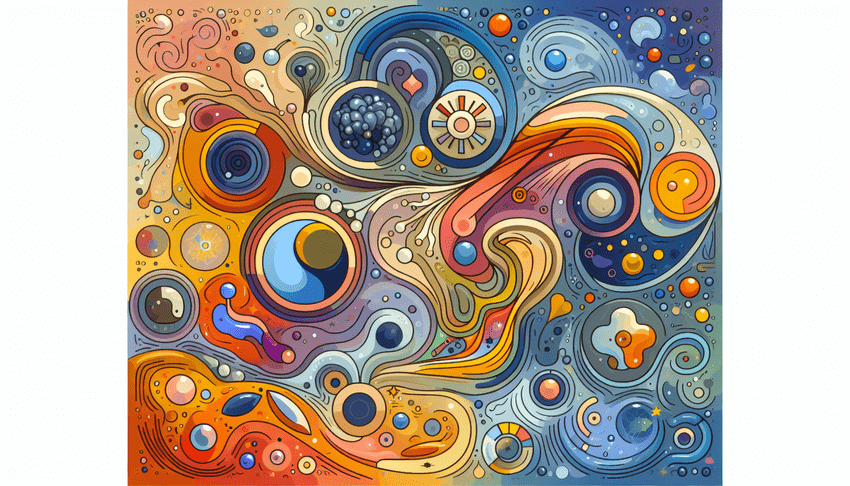Table of Contents
The Science of Joy

The Biological Basis of Joy
Joy, that exhilarating emotion we all chase, has roots deeply woven into the tapestry of our biology. While it might seem like an ephemeral sensation, the cascade of neurochemical activity that produces the feeling of joy is well-grounded in science. The dance of neurotransmitters such as dopamine and serotonin within our brains lays the foundation for experiences of happiness and contentment.
Let’s first shine a light on dopamine, often dubbed the ‘feel-good’ neurotransmitter. It plays a critical role in our reward system—a complex network that reinforces behaviors essential for survival. Possessing the key to our internal treasure chest, when dopamine levels surge in response to positive stimuli, it unlocks a sense of satisfaction and well-being. Imagine the burst of joy a musician feels as they hit the perfect chord, or the surge of pleasure when a runner crosses the finish line; these momentous sparks of joy are fueled by dopamine rewarding meaningful achievements.
- Serotonin is another architect of our emotional well-being.
- It helps regulate mood, appetite, and sleep—all vital for maintaining a harmonious state of mind.
- Its influence on mood can be so profound that many antidepressants are designed to increase serotonin levels in the brain.
Examples from everyday life offer a vivid illustration of serotonin’s effects. Take, for instance, a serene family meal or a restful night’s sleep; both events can elevate serotonin production, contributing to feelings of joy and peacefulness on the following day. The intimate relationship we have with sunlight also impacts our serotonin levels, emphasizing the importance of elements such as nature in the pursuit of happiness.
The science of joy extends beyond these neurochemicals, however. It envelops the entire body, including the autonomic nervous system which controls our ‘fight or flight’ and ‘rest and digest’ responses. When we experience joy, our parasympathetic nervous system—the ‘rest and digest’ part—helps our bodies to relax and thrive. The warmth of social bonding, such as the joy from a hug or engaging in heartening conversations, triggers oxytocin release, further promoting a sense of connection and happiness.
Understanding the biological basis of joy doesn’t just satisfy our curiosity; it empowers us to cultivate our well-being proactively. Activities like exercise, which is known to release endorphins, or engaging in social activities, which foster the release of oxytocin and serotonin, are not just fun—they are strategic moves in the chess game of happiness.
In the quest for joy, we now see the invisible players and understand how they make their moves within us. With this knowledge, we can better harness the power of our own biology to lead lives marked by greater happiness and fulfillment.
Joy vs. Happiness – Clarifying the Concepts
In the vibrant tapestry of human emotions, joy and happiness often emerge as prominent hues, yet each possesses its own unique shade. Joy Psychology and Emotional Joy Analysis delve into the essence of these experiences. Understanding the Psychological Aspects of Joy distinguishes it as a fleeting, intense burst of emotion typically sparked by a specific event. Happiness, on the other hand, unfolds in the Emotional Well-being Study as a broader, more enduring state, reflecting overall satisfaction with one’s life and circumstances.
Joy can be likened to a brilliant flash of lightning in the canvas of our lives, illuminating moments with its intensity. Birthdays, personal triumphs, or even the unexpected delight of a stranger’s smile can trigger this powerful, albeit brief, emotional response. Joy’s transitory nature adds a precious quality to it, something to be savored in the moment.
Happiness, as explored in the realm of Exploring Happiness Emotions, is the gentle glow of sunlight that permeates through our days. It is less about the instantaneous reactions to events and more about a pervasive sense of contentment. Whether stemming from fulfilling relationships, career satisfaction, or a deep sense of purpose, happiness endures beyond the ephemeral sparks of joy.
Research in these fields often employs tools like self-reported surveys, psychological assessments, and even physiological measurements to gauge these positive states. While joy might spike in the graphs of emotional response during specific instances, the graphs charting happiness tend to show a steadier, more sustained line.
Key differences between joy and happiness
- Joy is an acute, intense emotion linked to specific moments or stimuli.
- Happiness is a chronic state that represents a general sense of well-being and satisfaction over time.
- Researchers use various methods to measure and distinguish between these emotions quantitatively and qualitatively.
Both joy and happiness are crucial to our mental and emotional landscapes. Joy provides the peaks, the moments of ecstatic celebration that add vibrancy to life. Happiness, however, creates the base, the overall sense of meaning, and fulfillment that underlie our existence. While different, they are not exclusive; they intertwine and enhance each other, contributing collectively to our life’s experience. In learning to recognize and cultivate each, we enrich the texture of our emotional well-being, weaving a more contented narrative for ourselves.
Cultivating Emotional Intelligence for Happiness

Cultivating Emotional Intelligence for Happiness
Joy often seems like an elusive butterfly, flitting in and out of our daily lives. But what if we could nurture a garden that attracts and sustains this delightful visitor? The cultivation of such a garden begins with self-awareness, a cornerstone of Emotional Intelligence that allows us to recognize and appreciate joy in its many forms.
Understanding Self-Awareness Self-awareness is our conscious knowledge of our own character, feelings, desires, and motivations. It’s like having an internal mirror that reflects our true emotional landscape. With strong self-awareness, we can observe our reactions to daily events, understand the nuances of our emotions, and discern what truly brings us joy.
But why is this introspection pivotal for experiencing joy? Here are a few reasons:
- It helps us distinguish between fleeting pleasures and deep, abiding joy.
- It enables us to create and seek experiences that align with our core values and thus evoke genuine happiness.
- It empowers us to manage negative emotions, creating space for positive ones to flourish.
Identifying Joy Joy manifests in various ways: the serene contentment while reading a good book, the exuberant cheer of a celebration, or the quiet satisfaction of a job well done. To identify these moments, we need to tune in to the emotional responses our activities and relationships elicit. Are they making us feel uplifted, hopeful, and fulfilled? These are trademarks of joy.
Moreover, physical cues often accompany emotional states. A lightness in the chest, a spontaneous smile, or a feeling of warmth can all signify joy’s presence. By paying attention to these bodily signals, we can become more sensitive to when joy visits us.
Increasing the Frequency and Intensity of Joy Once we recognize joy in our lives, we can work on inviting it more often and with greater intensity. Positive psychology suggests several pathways to achieve this:
- Practicing gratitude: Acknowledging the good in our lives amplifies positive emotions.
- Cultivating optimism: Expecting positive outcomes can often heighten the joy we experience.
- Connecting with others: Building supportive relationships creates opportunities for shared joy.
To harness the full power of joy, reflection is key. For instance, if volunteering brings someone happiness, they could increase that activity. Or if certain friendships spark joy, investing more time in those relationships would be beneficial.
In summary, self-awareness acts as the compass guiding us toward our joy. By understanding our emotional responses and intentionally nurturing habits that foster happiness, we not only spot joy more easily—we make it an enduring guest in the gardens of our lives. Remember, joy is not just about big, momentous occasions; it often whispers in the mundane, and with self-awareness, we learn to hear it.
Enhancing Joy through Empathy and Social Connections
Joy – a three-letter word that encapsulates the most sought-after experience in human existence. Joy, although fleeting and elusive to some, can be cultivated and enhanced through intentional practices rooted in Positive Psychology. At its core, Positive Psychology is the scientific study of what makes life most worth living, focusing on the strengths and virtues that enable individuals and communities to thrive.
Empathy as a Pathway to Joy
Embracing empathy, an integral component of Emotional Intelligence, opens up a direct pathway to joy. Empathy allows us not only to see the world from another’s perspective but also to share in their emotions, whether those feelings are of triumph or tribulation.
- Consider the joy felt when empathizing with a friend who has achieved a long-standing goal; their happiness becomes contagious.
- Think about the sense of fulfillment when being there for a loved one during tough times, providing support and understanding.
It’s this profound connection between emotional attunement to others and the joy it brings that underscores the transformative power of empathy. Research in the realm of Positive Psychology continually highlights the positive feedback loop between feeling understood and experiencing joy.
Social Connections Foster Joy
Moving beyond empathy, nurturing social connections is crucial for cultivating lasting joy. Human beings are social creatures; our relationships act as a significant determinant for our overall well-being.
- A robust social network can provide a buffer against life’s stressors.
- Shared experiences, from the mundane to the extraordinary, become sources of joy when they are experienced with others.
- The reciprocity observed in strong social bonds can magnify feelings of joy, as acts of kindness and cooperation trigger the brain’s reward system.
Through building and maintaining meaningful social connections, we not only increase our Emotional Intelligence but also establish a firm foundation for joy. This is evidenced in numerous studies, showing that individuals with rich social ties tend to have higher levels of happiness and resilience.
Practical steps to enhance empathy and social connections can range from actively listening and showing compassion to spending quality time with friends and family and engaging in community service. By integrating empathy into our everyday interactions and fostering deeper connections, we not only enhance individual experiences of joy but contribute to a happier society.
In essence, the journey towards a more joyful life is inexorably linked with cultivating empathy and fostering robust social connections. Through the empirical lens of Positive Psychology, these constructs not only illuminate the path to happiness but also serve as actionable avenues through which every individual can amplify the joy in their lives and the lives of those around them.
Summary
Joy, an emotion we ardently pursue, is undoubtedly a pivot on which our well-being spins. This state of happiness isn’t just an abstract experience; it’s deeply rooted in the biological ballet happening within our brains. Dopamine, known as the ‘feel-good’ neurotransmitter, orchestrates moments of pleasure and triumph, akin to the rush a runner feels at the finish line. Simultaneously, serotonin—the mood regulator—quietly shapes our sense of calm, highlighting the simplicity in a family meal or the rejuvenating power of sleep.
In the tapestry of emotions, Joy stands out with its vibrant hues. Unlike the tranquility of contentment or the quietude of gratitude, Joy leaps forth from our very being, often shared in collective bursts of elation. It’s the uproarious laughter at a punchline or the communal pride in a team’s victory. Joy can stir in the spectacular and the everyday, providing us with an energy that nourishes our soul.
- Contentment is a muted satisfaction, grounding us after fulfilling moments.
- Joy, in contrast, is the spontaneous eruption of happiness that we often experience together.
Gratitude can sow the seeds of Joy but extends beyond it, ingrained in our ability to appreciate what we have and the people around us. It is this acknowledgement of life’s blessings that paves the way for a more fulfilling existence.
- Gratitude is a state of thankfulness, giving rise to joy but not its sole origin.
- Joy radiates freely, not always rooted in gratitude but blooming in various contexts.
Exhilaration, the intense cousin of Joy, powers us through peak experiences, those breathtaking moments of awe and achievement. Joy, however, is more versatile, whispering in the quiet appreciation of nature’s beauty or in the comfort of familiar company.
- Exhilaration rockets us into moments of intense delight, often during high-energy scenarios.
- Joy, more adaptable, visits us in both the extraordinary and the mundane.
Understanding the symphony of emotions that Joy leads is one piece of the happiness puzzle. Another critical element lies in the realm of Emotional Intelligence, particularly self-awareness. It’s through self-awareness that we discern the subtleties of our emotional responses and pinpoint what stirs Joy within us. This awareness can help us navigate toward experiences that resonate with our values, allowing joy to flourish.
Self-Awareness and Identifying Joy Self-awareness gives us insight into our personal triggers for joy. It enables us to differentiate between fleeting pleasures and lasting Joy, steering our lives in a direction that brings more profound satisfaction. Recognizing Joy goes hand in hand with embracing Emotional Intelligence, as it connects us on a deeper level with our feelings.
In the pursuit of increasing the frequency and intensity of Joy, Positive Psychology offers tools for cultivation.
- Practicing gratitude amplifies the positive and allows Joy to emerge more readily.
- Optimism can elevate the joy we find in future outcomes.
- Social connections are fundamental; the shared joy builds stronger interpersonal bonds.
In reflecting upon the pathways to Joy, it becomes clear that through gratitude, optimism, and fostering social relationships, we can fine-tune our ability to experience and relish in joyful moments more frequently.
Empathy, an Emotional Intelligence cornerstone, carves out a circuitous path to Joy by allowing us to connect deeply with others. It is through this understanding and sharing of emotions that we amplify our own experiences of joy.
- An empathetic exchange can become an infectious beacon of happiness for both parties involved.
- Being there in times of need not only fulfills the soul but integrates us within the joy of others.
The Role of Social Connectivity
Social ties are key to sustaining Joy. Our innate social nature indicates that relationships bear significant weight in our emotional well-being. The social fabric not only provides a safety net but becomes a source of Joy through shared experiences.
- A strong social epoch acts as a bulwark against the tumultuous, amplifying Joy through camaraderie and support.
- Acts of kindness within these networks trigger a rewarding cascade, reinforcing the joyous connections.
By thoughtfully engaging in actions that deepen our empathy and enrich our social connections, we harness the power of Joy, lighting up both our lives and those around us with its brilliance. Through the lens of Positive Psychology, we see that the intertwined nature of empathy, Emotional Intelligence, and social bonds lays the groundwork for a joy-infused existence, truly making life worth living. Let this insight inspire you to explore more about the art and science of happiness, and how you can make Joy a consistent guest in your life’s journey.
FAQ – The Psychology of Joy
What are the predominant neurotransmitters associated with the feeling of joy, and how do they interact with the brain’s reward system to produce this emotion?
The predominant neurotransmitters associated with the feeling of joy are dopamine, serotonin, and endorphins. Dopamine plays a crucial role in the brain’s reward system by reinforcing pleasurable sensations and anticipating rewards, contributing to feelings of euphoria and motivation. Serotonin enhances mood balance and contributes to well-being and happiness, while endorphins are natural painkillers that also boost pleasure, often released during activities like exercise, laughter, and eating certain foods, creating a synergistic dance of chemicals that culminate in the joyful experiences we cherish in life.
What are the key neurotransmitters associated with the emotion of joy, and how do they influence the psychological state of an individual experiencing joy?
Key neurotransmitters associated with the sensation of joy include dopamine, serotonin, and endorphins. Dopamine is often referred to as the ‘reward’ chemical, playing a crucial role in motivating behavior by inducing feelings of pleasure and satisfaction. Serotonin contributes to well-being and happiness, influencing mood balance, while endorphins are the body’s natural pain relievers, also enhancing feelings of euphoria. Collectively, these chemical messengers orchestrate a symphony in the brain, tuning an individual’s psychological state to one of elation, happiness, and contentment.
Question: How does the experience of joy influence our stress response system, and what are the neurological mechanisms involved in this process?
The experience of joy can act as a natural counterbalance to stress, as it tends to decrease the production of stress hormones like cortisol and adrenaline, encouraging a more relaxed state. Neurologically, joy activates brain regions associated with reward and pleasure, such as the prefrontal cortex and ventral striatum, releasing neurotransmitters like dopamine and serotonin, which promote positive mood and resilience to stress. By stimulating these pathways, joy not only provides immediate feelings of happiness but also contributes to a buffer against the physiological and emotional impacts of stress.








